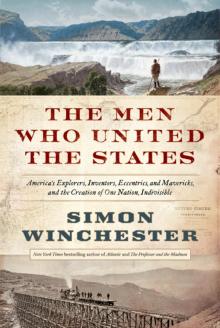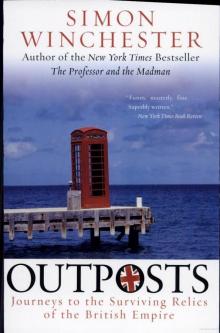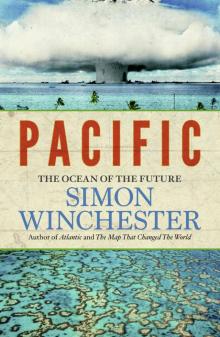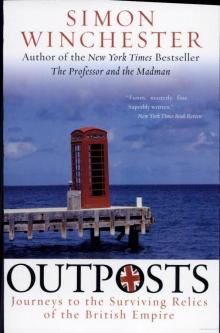- Home
- Simon Winchester
The Men Who United the States: America's Explorers Page 22
The Men Who United the States: America's Explorers Read online
Page 22
People suddenly found travel into the American interior delightfully uncomplicated. Pioneering, the Gold Rush, the peopling of the West—it all became so much simpler when the first half of the journey was so easily waterborne. Voyagers had only to embark on a series of watercraft that would bear them onward by way of the Erie Canal, the Great Lakes, the newly built connecting links of the Illinois and Michigan Canal, the Mississippi, the Missouri, the Platte . . . In short, with the arrival of the General Thornton, everything about the nature and being of Midwestern America began to undergo deep and permanent change, connected and civilized at a stroke.
It would be agreeable to report that Isham Randolph, the aristocratic Virginia axman, swept onto this vibrant scene half a century later like a knight on a white horse, improving and expanding an already great waterway and turning it into something truly magnificent. But the reality is somewhat uglier, even though the structure that remains today, what chart-makers and boatmen call the Illinois Waterway, does have an undeniable nobility to it.
The problem with late-nineteenth-century Chicago was that it had fallen victim to its own success and swift expansion in one particular way: it had far too much sewage. It had no way of getting rid of it. People were dying of the diseases that it spawned.
From time to time, huge rainstorms acted to flush this mess, and others equally terrible, out into Lake Michigan, from which the city drew its drinking water. Epidemics of dreadful waterborne illnesses were feared—though these fears were never actually realized. The hot, crowded city, its waterways often smelly and sickly, unfairly won a reputation akin to Calcutta’s, as a pestilential place killing itself slowly. Huge amounts of money were then spent to reverse the flow of the Chicago River and deepen the cut through the low hill in the west, to try to flush the wastes out and away, well away from the lake. But ever greater rainstorms—especially one of fantastic ferocity in 1885—undid all the good work, and it was finally decided that a truly enormous new waterway, with the unlovely name of the Chicago Sanitary and Ship Canal, should be cut instead. This waterway should provide a new, better, and bigger passageway for ships, but it should also allow the reversal of the flow of the Chicago River and take all of the growing city’s sewage out west, away from the lake, and send it hurtling down into the Mississippi, out of Chicago’s sight, out of the city’s mind.
Isham Randolph had come to know Chicago through working on its new railway system. He was not the natural choice to create the new canal, but it turned out that he had the vision and ambition to oversee the greatest earthmoving undertaking that had thus far been conducted in American history. His creation is only twenty-eight miles long—a dwarf in length compared with either the Erie Canal or the Illinois and Michigan Canal—but it is a giant in all other respects and still stands intact. It is more than two hundred feet wide and twenty-four feet deep. It required a new generation of machines to excavate it and a new generation of engineers to perfect its making.
Throngs of tourists came to see the men and their iron leviathans at work. They held their children up to see and hear the dynamite blasts. They came day by day to watch the limestone walls appear, running straight and true for miles, and to see great new canyons form in front of them, like one of the huge chasms out west that excited travelers were reporting having seen. This was becoming Chicago’s Grand Canyon, and it was made by man. And when Randolph and his crew broke the final wall on a bitterly cold January day in 1900, it seemed to a writer on the Chicago Tribune an almost apocalyptic moment:
“It is open! It is open!” went up from scores of throats as the water at last . . . had been made to start down the toboggan slide into the canal. The fall . . . was 24½ feet. . . . “It is the Niagara of Chicago,” Mr. Eckhart said as he stood, watching the waters, together with the ice and boulders, sweep down the chute and drive far into the wide canal, whose surface already was beginning to take on a rich mahogany brown. . . .
Engineer Randolph stood at one end of the structure and waved his hat triumphantly. The flooding waters sent heavy spray over the feet of the men on the pier, and threatened to carry the group, the pier and all the rest into the canal beneath. Like schoolboys on vacation, the drainage officials waved their arms and shouted.
Admiral George Dewey, hero of Manila, came up to open the canal in May 1900, so proud was Chicago of what it had made, so hopeful were its merchants that it would encourage even more trade—and also so relieved were its people to be able to dispose of their waste and send it off toward the cotton fields and poor country towns down in the Deep South.
Yet it has proved something of a disappointment, in truth. The railways built to occupy the same valley have taken the lion’s share of the goods traffic; barges carry grain, coal, and iron ore worth about $1.5 billon from the lakes down into the Mississippi Valley each year, a respectable though not sensational amount. Over the years, the canal has been plagued by troubles of one kind and another, including court battles of Dickensian length and tedium, usually involving disputes over the amount of water being taken from Lake Michigan each year.
For decades the canal was an overlooked part of the city’s infrastructure, a gray and listless swath of fetid water hidden away behind its cement walls, lying at the back end of the brickyards and treatment plants of the city’s western suburbs. In recent years, it has reemerged in the public consciousness for the worst of reasons: for though it has not proved to be much of a passageway for the promised tonnages of freight, it does now appear to be a potential entranceway for a most unwelcome visitor, making Isham Randolph’s proud venture the site of a most inglorious new war.
A non-native species of fish, the highly aggressive Asian carp, known for its ability to jump out of the water at high speed, terrifying humans who get in its way, as well as for its ruthless competition with native fish, was introduced into the lower Mississippi in the 1970s by commercial fishermen wanting to use it to clean their breeding ponds.
The spectacularly athletic Asian carp, which can leap up to ten feet out of river water, has long been at home in the Mississippi and its tributaries, but is not wanted in the Great Lakes, by either the American or the Canadian fishing industry, both of which it would decimate. Electric barriers across the Chicago Shipping Canal strive to keep it from entering.
It became astonishingly successful, and over the next three decades migrated in vast numbers upriver, traveling into the Illinois and Des Plaines Rivers and, much like Jolliet and Marquette three centuries before, arriving at the low hills that stood guard above the lowlands of Lake Michigan. But now, since the canals had breached those hills, there was a passageway into the lakes, with only the locks on the waterway acting as barriers. Were the carp to get across the barriers, they would upset the environmental applecart like no other introduced species before.
All efforts have since been made to keep the fish out, and the 112-year-old Chicago Sanitary Canal is now the last line of defense. Two powerful submerged electric-fence barriers have been installed, a high-voltage stockade to keep the fish away. But already, in 2011, one or two suspicious-looking creatures, bearing carpish genetic signatures, have been found in Lake Michigan, and it is feared that the barrier has not entirely held and that the lake may soon be fully fouled by a pest that would cause untold problems for the Great Lakes and beyond. It is a problem that no one foresaw, not even Louis Jolliet, who long ago imagined that a mere half-league ditch might unite the lakes and the gulf. It brings up the sobering thought that enforced unity can be a mixed blessing.
THAT OL’ MAN RIVER
I was once given an assignment to visit every town in America named Paradise. There were at the time sixteen of them, scattered randomly across the country from Pennsylvania to Nevada. Why, the editor wanted to know, would settlers want to call their new town by such a name? And if the towns had each seemed like Paradise back when they were founded, did they still warrant the naming? Was each Paradise a paradise nowadays?
It took two delightful months of wa
ndering to find out that only one of the towns truly deserved the name: I have long kept its exact location under my hat, other than offering that it is hidden somewhere deep in the wheat fields of the Midwest. While there, I was invited to stay with the town’s best-liked couple, who were improbably named John and Mary Angel. As if staying with the Angels in Paradise was not sufficient, Mary Angel one day collected cherries from a tree in her garden and baked me a pie. It all seemed a dream from which I never wanted to wake.
But most memorable of all was my discovery of the melancholy little community that had once been named Paradise, Arkansas, a dilapidated hamlet standing on a bluff above the right bank, the western bank, of the great American river, the Mississippi.
Paradise, Arkansas, is a town that no longer officially exists. It used to, and its name stands foursquare in the center of Drew County, on the Arkansas page of the National Atlas of the United States. But that was published back in the Nixon era, and much has changed in the years since. On the AAA road map of Arkansas today, most of Drew County is seen as being of so little consequence that the mapmakers put their compass rose right in its center. There are no places listed at all in this part of the county, least of all Paradise. When I called the Drew County clerk in Monticello—there are a lot of Jefferson-era place names in these parts, memorials to the Louisiana Purchase, which, among other things, made Arkansas a part of America—she said she didn’t know of any Paradise, though she did know of a place called Possum Valley.*
I insisted that there once was such a place as Paradise here. Maybe it was dead today, but I had been there for my 1984 essay, perhaps when the town was already just about done dying. It was hardly any sort of a community—no more than a gaggle of broken-down shacks perched on a low rise under a stand of live oaks. A few impoverished-looking men lolled about in the drowsy heat, fanning themselves.
When I sat with them, they told me that at the turn of the century, the hamlet had been a fairly prosperous site of a cotton gin and that bales would be sent by horse and cart down to the bayou nearby and loaded onto steamboats for shipment to New Orleans. But then the abler men drifted off to the Northern cities—to Detroit, mostly—and in more recent years, the Georgia-Pacific Company had come along and bought up the land for pine-tree plantations and pulp making, and Paradise started to die. In a year or so more, the men agreed, it would be quite gone, erased from the maps forever.
But then one of the older men stood up and took me to the edge of the live-oak copse. “You’ll be wondering why it was called Paradise,” he said. “Well, look down east a ways and try to imagine.”
I squinted into the sun, peering through the gray haze shimmering with restless thermals. Below was the bayou, a complex network of swamps and curved lakes and relic streams that glinted like hammered steel in the high sun. And then in the far distance, soundless and immense, was the Mississippi, wide and brown, a huge painted swath turning lazily down through the valley.
“Can you imagine,” asked the old man, “just how hot it must be down there today?”
It was certainly as hot as Hades up here on the hill.
He continued. “Can you imagine those men from long ago, paddling a raft for miles across the river, coming down from Memphis, or from closer places like Tunica or Clarksdale, and then hauling themselves and their supplies across the swamps, with all that mud and the mosquitoes and the steamy heat like today’s?
“But then they’d see this hill. A low hill, nothing more, but a place that catches the western wind a little, and has a grove on top where there is some shade. The men would climb up and take a rest under the oak trees. And then the sun would set over the hills, and a slight breeze would spring up to cool them down. Can’t you imagine them lighting cheroots and saying to themselves, ‘Now this is surely heaven! After what we’ve been through, this is paradise. Let’s set ourselves down and stay awhile’?”
That was how the town was founded, he said. Perhaps, perhaps not. I am sure there is truth in his story, even though the Drew County Historical Society knows nothing and the Monticello archivist has never heard the tale. Yet Paradise, Arkansas, is still on the National Atlas map. It has a set of coordinates: 33° 32′ North, 91° 47′ West. And I went there, many years ago. All that is quite enough.
But the other significant thing for me was just as the old-timer had said. Despite all its evident shortcomings and poverty and nowhereness, this oak-lined bluff must have once seemed a heavenly place to those who for days before had been mired and swamped in the great miles-wide tract of torrid unpleasantness that is the middle course of the Mississippi River.
It has always been my experience—quite different from the writings of Mark Twain, who made this river into a kind of magic carpet—that the Mississippi is a thing shorn of all romance and is instead more generally a displeasing mess of foul water, mud, slime, and desolation.
Charles Dickens saw “nothing pleasant in its aspect.” Mrs. Trollope wrote that she “never beheld a scene so utterly desolate.” And I suspect most others who see the Mississippi, at least in these reaches, feel about it much the same. It is mighty. It is important. Some say it is perhaps the most important river in the world. But pretty it is not.
If driving, you become aware of its presence miles before you reach it. The landscape falls away. There are swamps on either side, dense hedgerows and copses, miles of small lakes of curious shape. There are the distant chimneys of power plants and factories, sited at the river’s edge because, presumably, the owners are eager to take advantage of some neighbor-state’s tax benefit. And then finally there is a bridge, usually an iron behemoth of a thing. Often bridges come in threes: there is the one being driven over, another beside it built later on to accommodate the unanticipated extra traffic, and also perhaps a rusting railway crossing nearby, built in much earlier times, and maybe also the empty stone pillars of one that long before had been half demolished or destroyed.
The road bridge then heaves itself up and over yet more swamp, more trees, then yards of soggy ooze, then an inlet and an islet and a stranded barge or two, then a fuel depot and another islet and yet more brown sludge, before finally the river itself appears below, eau de nil in hue and filled with floating mysteries and perhaps a slow-moving barge or two, its waters rumbling past beneath the span—until, a mile or half a mile on, there is more ooze and low forest, and the process repeats, a mirror of what went before, and then there is a bullet-riddled “Welcome” sign, telling you how good it is to be in Arkansas or Louisiana or Missouri and reminding you that Mississippi, Kentucky, Tennessee, and Illinois are all in the rearview mirror now, that East has become West, and the West will be everything for the next two thousand miles or so.
Despite Saint Louis’s best efforts to make its own stretch of riverfront pretty and rich with symbolism by having a master craftsman like Eero Saarinan put up his mighty steel-clad Gateway Arch on the right bank, the crossing of the Mississippi in America’s midregion is seldom a pleasant experience. Though the waterway may be of enormous national significance, both real and symbolic, I imagine the transit of it to be only a little more pleasant today than it was when those nineteenth-century settlers flung themselves ashore on a cool Arkansas bluff and declared that they had at last found paradise. That they did so was not because Arkansas was heavenlike but because what had gone before on America’s greatest river had been so very disagreeable.
The story of America’s unification has, by and large, been a saga played out along an east-west axis known by the well-worn phrase “from sea to shining sea.” But the country’s most obvious physical feature, the great gray-green greasy Mississippi, does not run that way at all. It lies at right angles, almost precisely north to south,* a fact that renders it at first blush less a unifier than a dividing line, at least symbolically, a boundary delineating where the American East becomes the American West. But a new-made nation demands to be unified across all of its dimensions, Minnesota and Louisiana, North Dakota and Texas being quite as wor
thy of connection as are Maine and California, Virginia and Oregon.
The river itself spills out of a small lake amid the birch forests of northern Minnesota. Henry Schoolcraft, the geologist-explorer who first found its source in 1820, liked to give pronounceable pseudo-Indian names to features he found, and he gave this lake the name Itasca, which is not even remotely Indian, but a cornily truncated version of the Latin words for “truth” and “head.” Though one of the streams that feed the lake is presumably the Mississippi’s real source, it has become convenient to present a spillway at the lake’s northern tip as the accepted beginning of the river, and there is a marker, a stone walkway, and a large car park to denote the official start of the nation’s greatest stream.
From this point, the stripling continues northward for a few miles, runs cold and narrow and waving with fronds of wild rice that the local Indians are permitted to grow, then doubles back and proceeds southward, steadily widening and deepening as it goes. It is artificially dammed and nudged by its state and federal caretakers into staying between its banks, and for five hundred miles it thrusts itself fast and rockily southward. Then as it leaves the northern states, it matures and steadies itself, and after seventeen hundred more muddy miles of slow curves and recurves, it finally reaches the sea in the Gulf of Mexico.

 The Surgeon of Crowthorne
The Surgeon of Crowthorne Korea: A Walk Through the Land of Miracles
Korea: A Walk Through the Land of Miracles The Men Who United the States: America's Explorers
The Men Who United the States: America's Explorers Outposts: Journeys to the Surviving Relics of the British Empire
Outposts: Journeys to the Surviving Relics of the British Empire Atlantic: Great Sea Battles, Heroic Discoveries, Titanic Storms
Atlantic: Great Sea Battles, Heroic Discoveries, Titanic Storms The Professor and the Madman: A Tale of Murder, Insanity
The Professor and the Madman: A Tale of Murder, Insanity A Crack in the Edge of the World
A Crack in the Edge of the World The Perfectionists: How Precision Engineers Created the Modern World
The Perfectionists: How Precision Engineers Created the Modern World The Man Who Loved China: The Fantastic Story of the Eccentric Scientist
The Man Who Loved China: The Fantastic Story of the Eccentric Scientist The River at the Center of the World: A Journey Up the Yangtze
The River at the Center of the World: A Journey Up the Yangtze The Fracture Zone: My Return to the Balkans
The Fracture Zone: My Return to the Balkans The Map That Changed the World
The Map That Changed the World Krakatoa: The Day the World Exploded
Krakatoa: The Day the World Exploded The Man Who Loved China
The Man Who Loved China The River at the Centre of the World
The River at the Centre of the World Bomb, Book and Compass
Bomb, Book and Compass The Perfectionists
The Perfectionists The Meaning of Everything
The Meaning of Everything Exactly
Exactly Atlantic
Atlantic Korea
Korea The Fracture Zone
The Fracture Zone Pacific
Pacific Krakatoa
Krakatoa The Professor and the Madman
The Professor and the Madman Outposts
Outposts